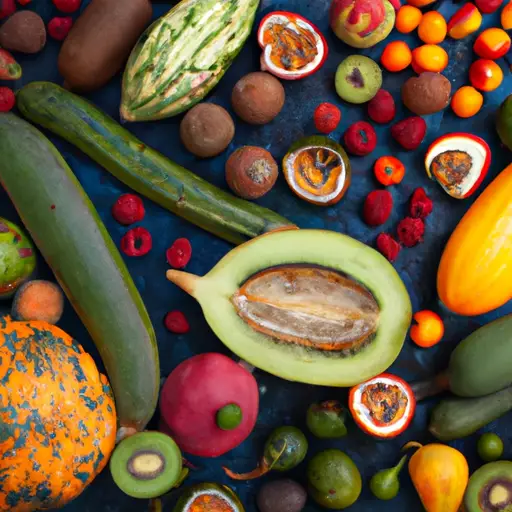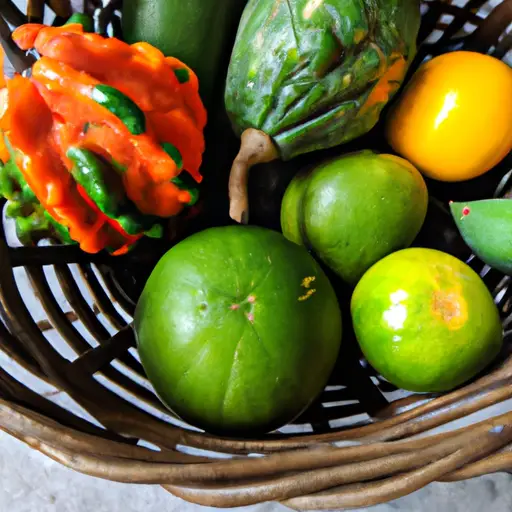An Overview of Exotic Fruits and Unique Vegetables
Introduction:
One of the joys of exploring different cultures and cuisines is the opportunity to taste exotic fruits and unique vegetables. These vibrant, unusual foods not only add variety to our meals but also provide us with a wide range of vitamins, minerals, and antioxidants. In this article, we will take an overview of some fascinating exotic fruits and unique vegetables that are worth exploring.
Exotic Fruits:
1. Dragon Fruit:
Dragon fruit, also known as pitaya, is a visually striking fruit with a vibrant pink or yellow exterior. The flesh inside is white or red, dotted with small black seeds. It has a mild flavor reminiscent of kiwi or pear. Dragon fruit is rich in vitamin C and antioxidants, which boost immune health.
2. Durian:
Often referred to as the “king of fruits,” durian has a strong odor that can be an acquired taste for some. Its spiky exterior hides a creamy flesh that tastes sweet and custard-like. Durian is high in fiber and contains various nutrients such as potassium, vitamin C, and iron.
3. Mangosteen:
Mangosteen is a tropical fruit with a purple rind that must be cracked open to reveal soft, juicy segments. It has a sweet, tangy flavor similar to citrus fruits. Mangosteen is packed with antioxidants called xanthones, which have anti-inflammatory properties and support overall health.
4. Jackfruit:
Jackfruit is the largest tree-borne fruit in the world and has been gaining popularity as a meat substitute due to its texture when cooked. It has a sweet taste when ripe and can be used in both savory dishes like curries or desserts like ice cream. Jackfruit is rich in fiber and vitamin B6.
5. Custard Apple:
Custard apple is an unusual-looking fruit that resembles an artichoke or pinecone. When ripe, the knobby green exterior gives way to creamy flesh that has a sweet, custard-like flavor. It is a good source of vitamin C, fiber, and potassium.

Unique Vegetables:
1. Romanesco Broccoli:
Romanesco broccoli is a visually stunning vegetable with bright green fractal patterns that resemble a natural mathematical sequence. Its taste is similar to regular broccoli but slightly nuttier. Romanesco broccoli is rich in vitamins C and K and contains unique compounds with potential anti-cancer properties.
2. Purple Brussels Sprouts:
While the taste of purple Brussels sprouts is similar to their green counterparts, their vibrant purple hue adds a pop of color to any dish. They are packed with vitamins C and K and offer antioxidant benefits due to their anthocyanin content.
3. Kohlrabi:
Kohlrabi is often mistaken for an alien vegetable due to its unusual appearance. This bulbous vegetable has a mild, sweet taste that resembles a cross between cabbage and turnip. It is an excellent source of vitamin C, fiber, and potassium.
4. Golden Beetroot:
Golden beetroots provide an interesting twist on the classic red variety. Their golden color adds vibrancy to salads and roasted dishes while having a slightly milder flavor than red beets. These roots are rich in antioxidants like betaine, which promotes heart health.
5. Chayote:
Chayote is a versatile fruit often used as a vegetable in culinary preparations. It has a mild taste reminiscent of cucumber or zucchini and can be enjoyed raw or cooked in various dishes such as stir-fries or soups. Chayote is low in calories but rich in fiber, potassium, and folate.
Conclusion:
Exploring exotic fruits and unique vegetables opens up new culinary experiences while providing us with an array of health benefits. Dragon fruit, durian, mangosteen, jackfruit, custard apple, romanesco broccoli, purple Brussels sprouts, kohlrabi, golden beetroot, and chayote are just a few examples of the diverse and intriguing foods that nature has to offer. Incorporating these exotic fruits and unique vegetables into our diet not only adds excitement to our plates but also boosts our overall health with their impressive nutritional profiles. So why not embark on a culinary adventure and savor the deliciousness of these extraordinary foods?













